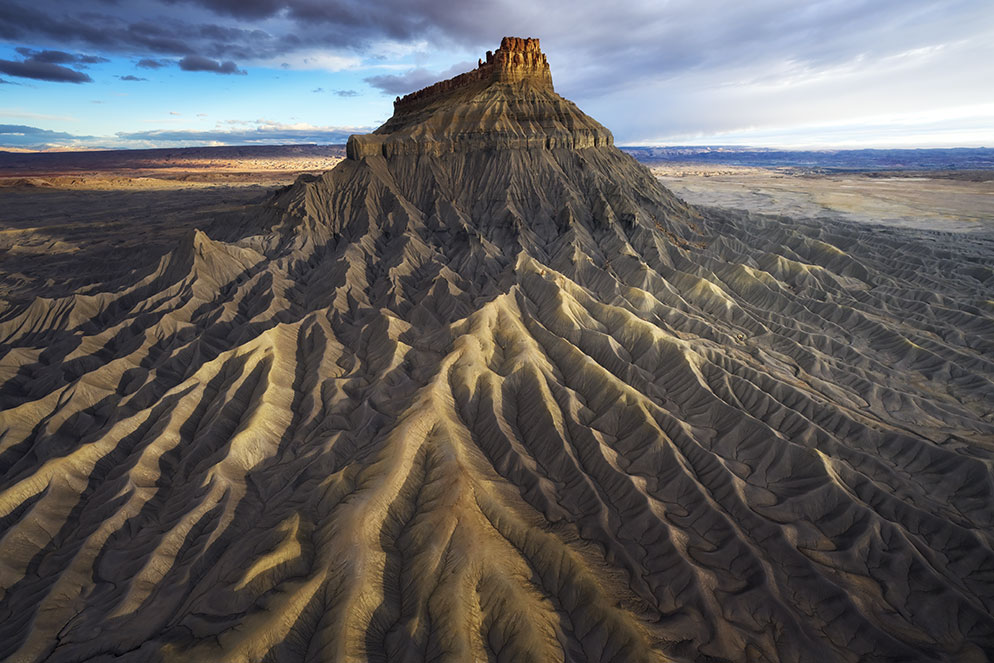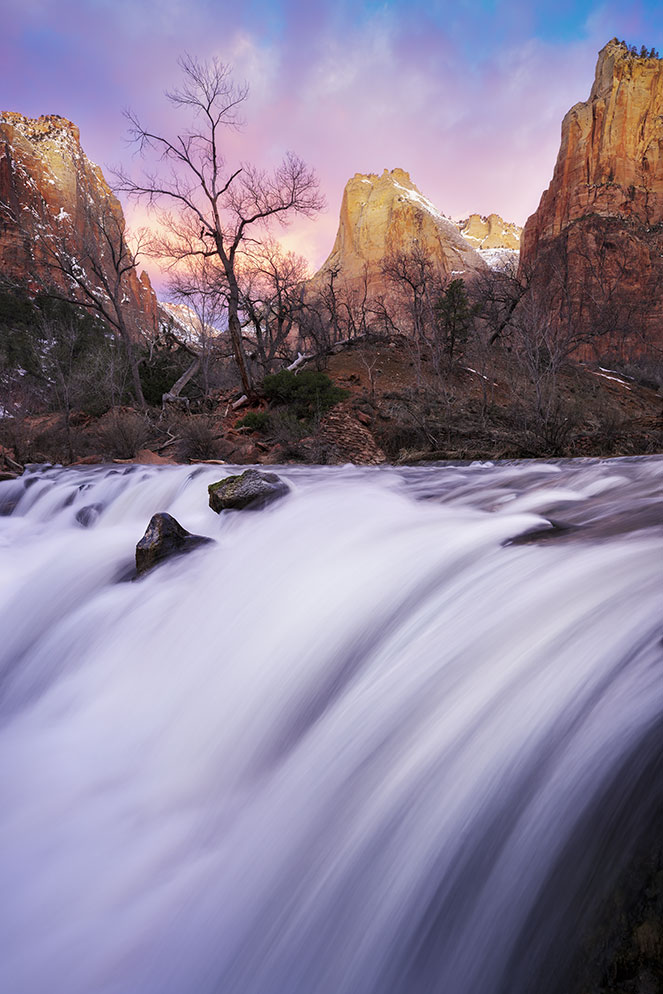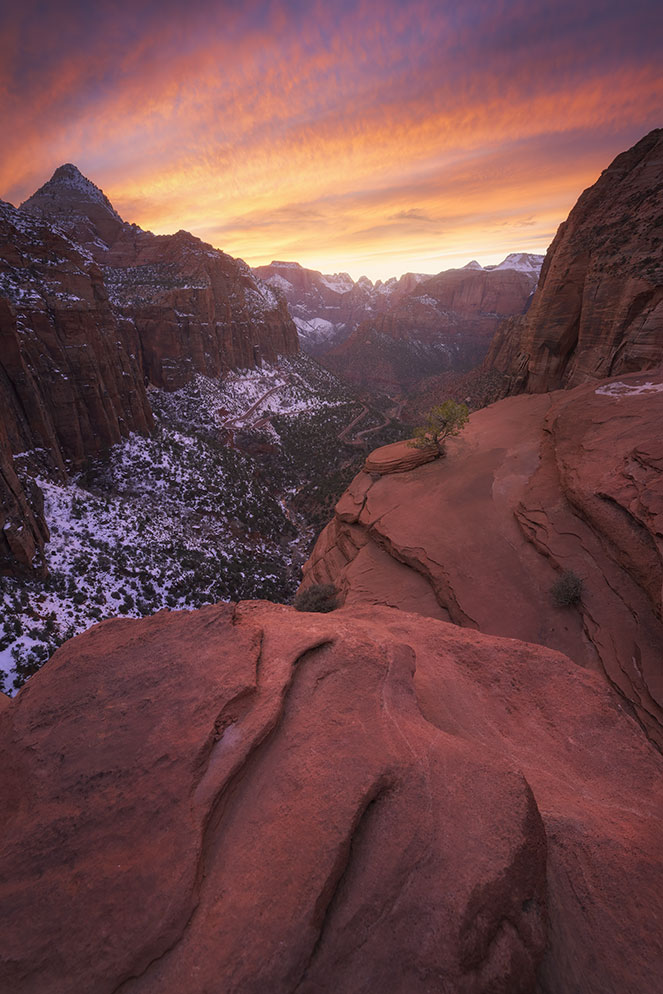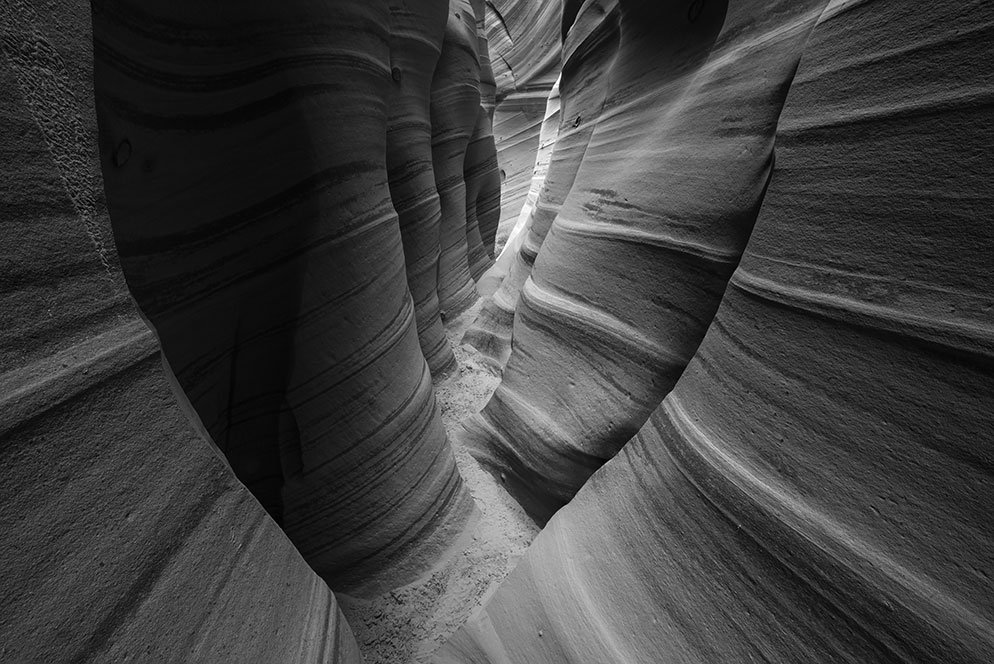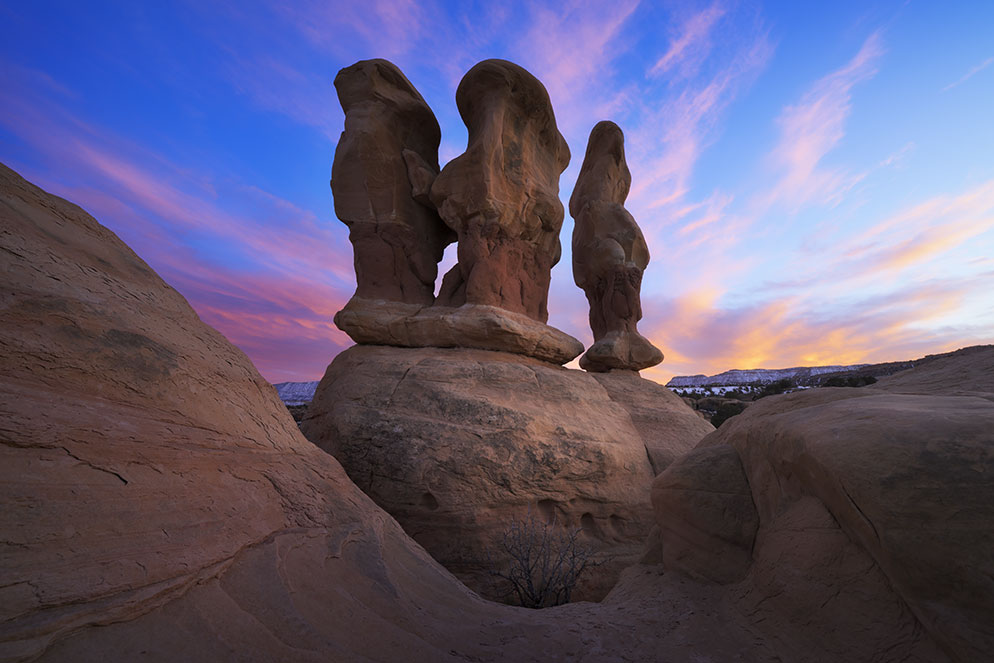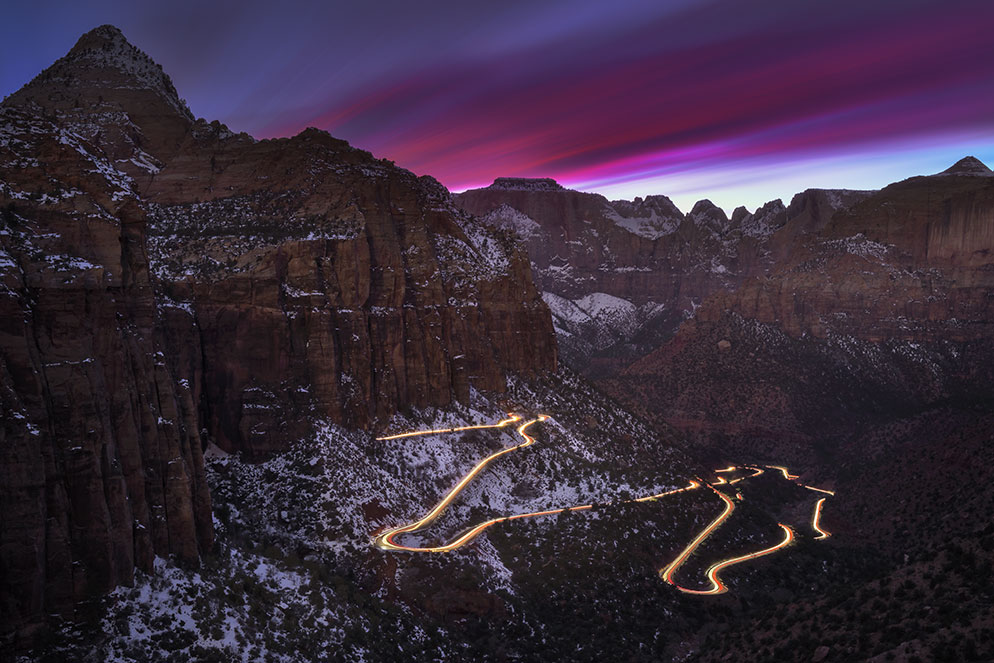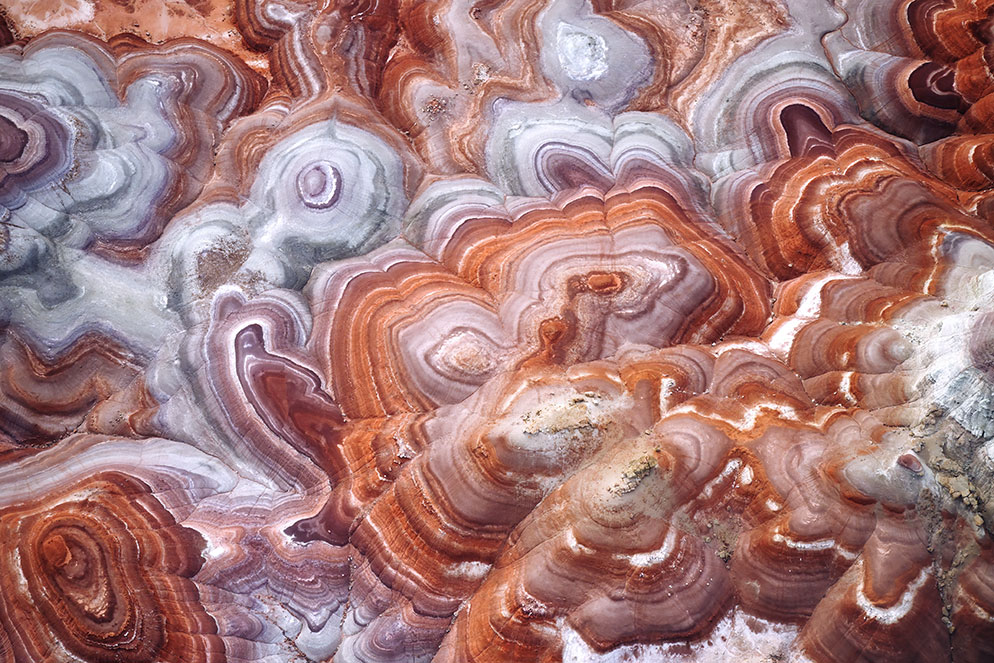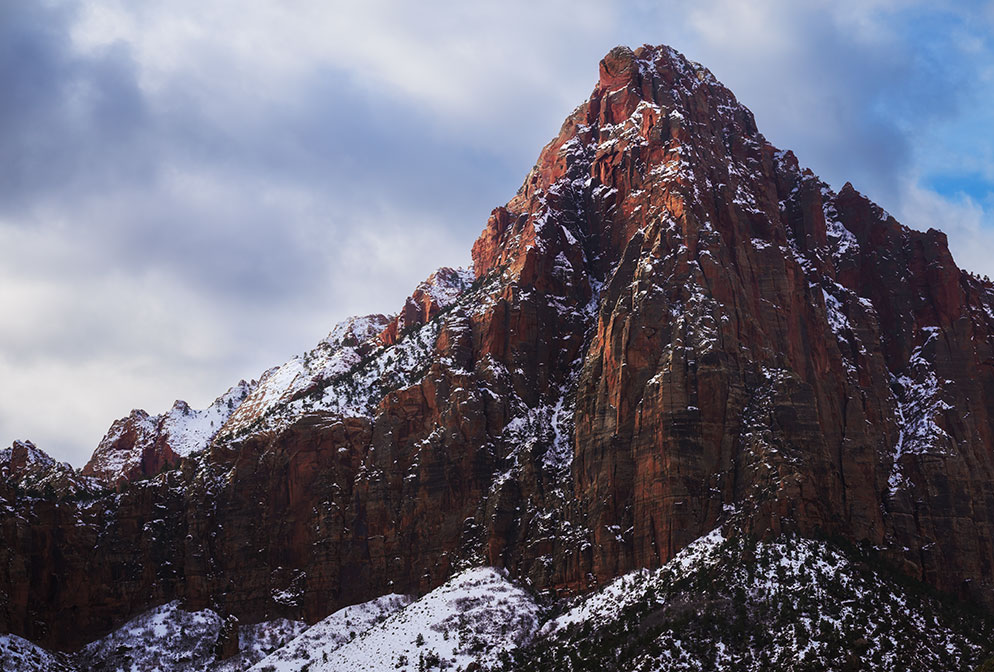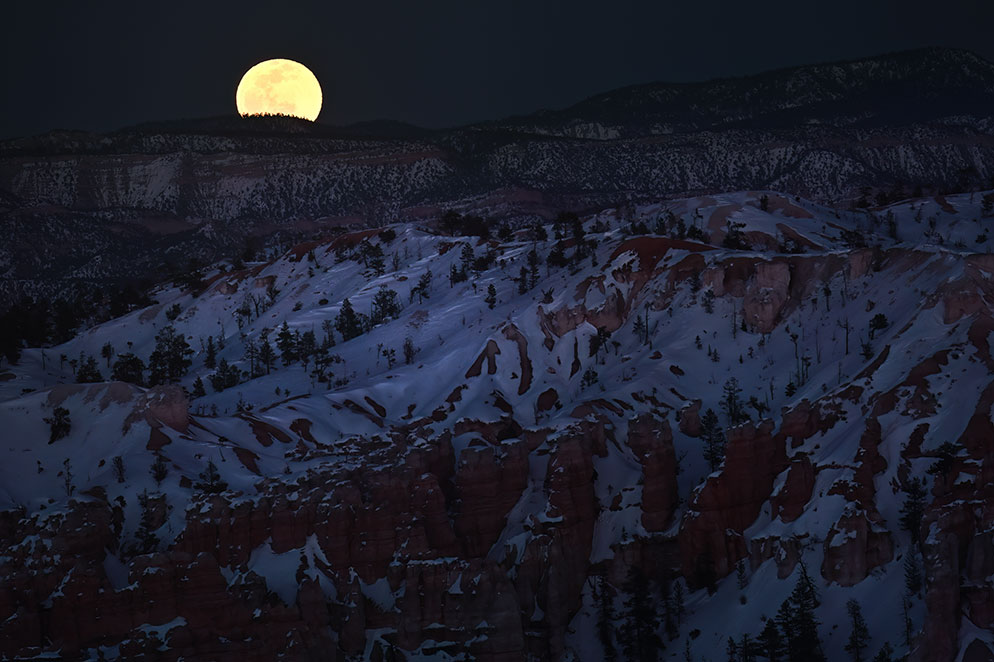Why the Z 8 Might Be the Ultimate Camera For the Greater Outdoors
Mike Mezeul does not take walks in the park.
“Landscape photography, to me, is not pulling up in a national park and walking out to an observation point that’s 30 feet from the car,” he says. “It’s putting yourself in the elements and having gear that allows you to put yourself in those elements.”
You might say that the gear has to match nature’s versatility—which is pretty much the story of Mike’s images. The camera for the video and stills you see here was a Z 8, and it proved to be a perfect fit for the greater outdoor images he loves to create.
We say “create” because it’s exactly what he does, and here’s how that story goes.
Day One
Z 8, NIKKOR Z 14-24mm f/2.8 S, 1/3 second, f/9, ISO 100, manual exposure, Matrix metering.
“This is the morning of the first day I shot with the Z 8,” Mike says. “I’ve been to Zion National Park many times, and this is the scene I wanted to capture. I knew I could make a dynamic, storytelling image if I could get close to the waterfall and working with the wide-angle 14-24mm Z lens allowed me to capture the water rushing through the scene and also get the mountains in the background.”
But it wasn’t quite that easy. “The camera is on my tripod, which wasn’t tall enough to get the angle I wanted, so I’m holding the camera up, shooting with one leg of the tripod on a slippery rock, the other two just hanging out in space. I’m soaking wet and getting deeper and deeper in the water because I had to get that tree exactly where I wanted it—in the somewhat negative space between the two peaks.”
Like we said, no walks in the park.
Intent
Z 8, NIKKOR Z 14-24mm f/2.8 S, 1/3 second, f/10, ISO 200, manual exposure, Matrix metering.
Z 8, NIKKOR Z 24-120mm f/4 S, 1/30 second, f/18, ISO 320, manual exposure, Matrix metering.
“Every landscape photo I take, there’s intent—a specific reason I set the camera right there rather than three feet to the left or right, higher or lower. This was still day one, in Zion, and the sole reason I went to this overlook was the little tree out on the ledge; I absolutely love the little splash of life there. A lot of people will shoot this popular area in an overall composition, but I wanted a different story. Here’s a location with leading lines, textures, color contrasts, and then there’s something out of place that nature put there: the little tree.” Mike captured that story in the photo on the left; then, in the right-hand photo, the tree becomes the subject. “In the first shot you can tell it’s a little tree, but on the right you see all the details and textures of the rock it’s growing out of. Wide perspective, then tight, and for both shots I got very lucky with the sunset.”
Close Quarters
Z 8, NIKKOR Z 14-24mm f/2.8 S, 3/5 second, f/18, ISO 200, manual exposure, Matrix metering.
“This is in Utah, in Zebra Slot Canyon. I shot it in color, and the colors worked well with the textures and how the rocks were catching highlights and shadows, but the canyon’s all red, and the image felt a little flat, so in the digital darkroom I removed the color, and I really liked the feeling black and white gave to the image.
“It’s a heck of a hike to just get to this location, and then you’re wading through water in a canyon where at times you have to suck in your chest to get through. Props to the Z 8 and its size and weight—it made the journey a lot easier than a larger camera would have.”
Turnaround
Z 8, NIKKOR Z 14-24mm f/2.8 S, 1/2 second, f/10, ISO 100, manual exposure, Matrix metering.
“This is a rural spot in southern Utah, and the picture is a lesson in having patience. I’d written off the sunset and was walking away and just turned back for a moment and, Oh, there’s a pink glow, and then, Oh, there’s a lot more. So, I ran back, and because I’d already scouted the composition I knew exactly where to go. The right side is the last of the sunset; on the left the start of blue hour is coming in. I’m a lover of transition, and this is a sunset-to-twilight sky right there.”
High Rise
Z 8, NIKKOR Z 14-24mm f/2.8 S, 1/500 second, f/9, ISO 500, manual exposure, Matrix metering.
Taken at sunrise from an ultralight aircraft over southern Utah, Mike’s goal for this image was to capture the 6,000-foot-tall butte illuminated by low-angle light skimming across the ridges to reveal “the incredible textures and details—almost like the veins of the earth.”
There was a lot of intent behind this shot. “I wanted a little bit of the light at the top of the butte with the cloud’s shadow in the middle, and a little bit of light on the base. If we got higher up, the butte shrinks down and you lose the scale; lower, it’s too massive, too overwhelming. We took a few stabs at the altitude to find what I think is the perfect angle.”
Z 8 Minutes
Z 8, NIKKOR Z 24-120mm f/4 S, 480 seconds, f/16, ISO 80, manual exposure, Matrix metering.
“This was taken from a spot about 50 feet to the left of the Zion tree. It’s a 480-second exposure—the Z 8 can shoot at up to 900 seconds—and the idea was to capture motion in the clouds to get a painted look, and to get the lights of cars coming down the switchbacks from the tunnel in the mountain.” Mike timed a car coming from the tunnel to the valley and found it took eight minutes. He set the camera, waited for the next car, hoping its speed would be close to his test car’s. It was.
Life on Mars
Z 8, NIKKOR Z 24-120mm f/4 S, 1/1000 second, f/4, ISO 800, manual exposure, Matrix metering.
If you’ve no idea what you’re looking at, neither did we. “It’s the reason I love to shoot landscapes from the air. From the ground what you see is a pile of rocks, but from 500 feet up in an ultralight you’re looking at the geology, geography and geometry of this area in Utah, at layers of colors and patterns. It’s Mars; it’s other-worldly. You could never experience this kind of beauty and wonder unless it’s from a bird’s-eye view.” Mike had previously photographed the area with a drone; this time he wanted to see it and share it in the high resolution and dynamic range the Z 8 delivers.
Selective Focus
Z 8, NIKKOR Z 100-400mm f/4.5-5.6 VR S, 1/50 second, f/5.6, ISO 64, manual exposure, Matrix metering.
“You can look at an overall landscape and see mountains, hills and rocky terrain, but to really appreciate what’s going on you sometimes have to take a closer look, and that’s why I always hike with my 70-200mm or 100-400mm. There are often very localized areas within landscapes like this one, areas where the light is, areas that hold their own beauty. This one peak in Zion was getting all the light, everywhere else was flat, so I threw on the 100-400mm and focused on that peak and worked the directional light to get the reds and the contrast of the snow and the blue sky. This was one of those ‘limit and isolate’ times when I needed to adapt to what I was given.”
Moonrise
Z 8, NIKKOR Z 100-400mm f/4.5-5.6 VR S, 1/20 second, f/5, ISO 500, manual exposure, Matrix metering.
Night-sky photography is a passion for Mike, and the Z 8 has two features that are especially welcome: warm display colors, so he doesn’t lose his night vision when making settings changes; and image frame display, so he can view in the finder a thin white-line rectangle that confirms his composition.
“This shot was the reason I was in Bryce Canyon. I knew there’d be a full moon, and I used a few apps to figure out my positioning. When you’re shooting a moonrise with a wide-angle lens it seems to take forever; when you’re shooting it with a 100-400mm it rises pretty quickly, so I had to be extremely accurate on my planning of where the moon was going to come up. I wanted to get it positioned precisely where you see it.
“This was another shot that tested the dynamic range of the Z 8: bright moon, dark shadows, blue tones. Add in that the temperature was minus 14 degrees and let’s say the scene was incredible to see but nerve-racking to shoot.”
The Rest of the Story
“I’ll let you in on something,” Mike says when we mention his previsualization of images. “For all my shoots I’m very traditional, and I actually storyboard everything. That can be from simply thinking about it and visualizing it, to actually taking a 3x5 notecard and drawing my vision for what I want to create, and for this shoot, there was never a doubt that the Z 8 was going to give me what I wanted.”
In fact, there was increased confidence. “There were instances—like shooting from the ultralight—where having a bigger, heavier camera would have added to the challenge. I actually mounted the Z 8 on the wingtip of the ultralight at one point, and that would not have been possible with a heavier camera.”
Nature, of course, is more than enough of a challenge. “There’s so much unpredictability,” Mike says. “You try your best to find the locations, to plan for the best light, to create a unique, storytelling composition—and then the rest is up to nature. The last thing you want to worry about is the gear in your hands, and that’s one of the reasons that for my whole career I’ve shot Nikon. With the Z 8, as soon as I picked it up, I was like, I know I can put this thing through it all. I’ve got pure confidence, now let’s see what I can do with it.”
Z 8 Behind the Scenes - Landscape and extreme nature photographer Mike Mezeul announces his motto right at the start: “Let’s go!” It’s a beautiful, swift ride, and our Z 8 caught it all.

